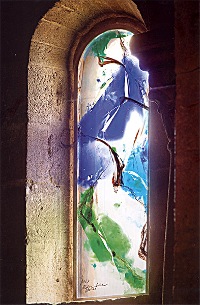Research project and scientific committee
VIII International Liturgical Conference
LITURGY AND ART
The challenge of today's world
Bose, 3-5 June 2010
Monastery of Bose
National Office for the Cultural Heritage of the Church – CEI
 RESEARCH PROJECT AND SCIENTIFIC COMMITTEE
RESEARCH PROJECT AND SCIENTIFIC COMMITTEE
The relation of the Church to the arts has for long been an object of debate. In Europe and elsewhere attempts have been made to improve these relations ever since Paul VI deplored their interruption in his renowned discourse of 1964, to which pope Benedict XVI referred in his meeting with artists on 21 November 2009, when he too emphasized how much the Church has need of artists. The VIIIth International Liturgical Conference of Bose intends to deal with the real tension that exists between the claim to autonomy by art and its assumption to the Church’s service.
In the relation between liturgy and art it will be necessary first of all to clarify whether the usual distinction among ars religiosa, ars sacra, and ars liturgica can be of help. The discussion will be conducted in the widest possible vista of an aesthetic of the Christian faith and its expression in the liturgy. Faith, in fact, seeks to be rendered perceptible not only in listening to the word of God, but also through the other senses, especially that of sight. The dimension of sense proper to the Christian faith belongs to the essence of Christianity as revealed religion; the mystery of the incarnation continues to operate in the Church’s sacramental structure and its liturgy. This relation constituted the theological basis that marked the end of iconoclasm and made possible an immense artistic production in the Churches in both East and West.
In the measure in which art represents a “language” that can transmit the experience of what is transcendent, there is an analogy with the liturgy in its symbolic verbal and non-verbal language. Nevertheless, the liturgy is actio sacra, while the figurative arts are static and suspend the experience of the flow of time by shifting it to the observer’s intimate depths. This is their force, in the measure that they prolong beyond the instant the experience of the meeting with God in word and sacrament. Throughout the Church’s history, however, there continue to be iconoclastic tendencies that would like to put an end to the temptation to depict what cannot be depicted.
The discourse on art and the Church has been conducted almost exclusively from the side of the Church, by the magisterium and by theologians. If the Church requires the artist to wok in conformity with the liturgy, is she disposed to have artists require something from her? Artists are supposed to serve only the requirement of beauty of the Church, and other registers of human experience, as happens in contemporary art, are not to be received? The popes have recognized this task of artists. John Paul II has spoken of art as a “voice of expectation of universal redemption, while Benedict XVI has affirmed that “art should disquiet, science reassure”.
The liturgical conference will use a wide concept of “image”. A distinction should be made between primary and secondary images. The primary image is the liturgical assembly itself (Christ and the visible community) in its various communicative actions. Aniconic liturgical spaces, such as Cistercian churches, churches of the Reform, and churches of the twentieth century, are not empty of images, although they do not exhibit any or few images in the classic sense. Not by chance the liturgical movement of the twentieth century preferred to a great extent churches without images, because greater importance was given to the primary image, which is the liturgical action itself. At the beginning of the last century there was often a removal and a reduction of many images that had accumulated in historical churches, but towards the end of the 1900s images returned in a large part of Europe, and someone spoke of an “iconoclasm in reverse”. We have to ask whether there is a risk that images become again, as had happened already in the nineteenth century, a surrogate of the liturgical celebration, which often is defective in language, in expression, and in eloquence.
The conference will gather the experience of architects, of artists of the figurative arts, and of theologians to reflect on how the separation “between temple and museum” (Alex Stock) is to be dealt with. In addition, there will be a presentation of experiences of encounters between liturgy and contemporary art in several European countries and within various Christian confessions.
Scientific committee: ENZO BIANCHI (Bose), STEFANO RUSSO (Roma), GOFFREDO BOSELLI (Bose), FRÉDÉRIC DEBUYST (Louvain-la-Neuve), PAUL DE CLERCK (Paris - Brussel), ALBERT GERHARDS (Bonn), ANGELO LAMERI (Roma), KEITH PECKLERS (New York - Roma), GIANCARLO SANTI (Milano).